IN THE NEWS
[1] FIRST SERGEANT JOSEPH McCURRY, COMANY H

A late 1800s lithograph of a baseball game.
- Theodore Ewert, Company H, 7th U.S. Cavalry, confided to his diary1 that “McCurry delivers a swift and correct ball, generally to suit the batter, is a sure base runner, briskly if it pays, earns his runs, and is a gentlemanly player withal….He is undoubtedly the stay and prop of the club, and is also the best player.”
- Joseph McCurry, son of Irish immigrants, was born in Philadelphia, Pennsylvania, mostly likely in 1853, not three years earlier as virtually every biographer has led us to believe.
- He was enlisted into the U.S. Army by Captain Samuel Whitside on 22 January 1872 in Philadelphia, at a stated age of 21, and described as having brown eyes, dark hair, a ruddy complexion, standing 5’ 7” tall, previously employed as a coach maker. From Philadelphia McCurry was sent to the St Louis Depot, Missouri where, on 2 February 1872, he was transferred via the General Mounted Recruiting Service to the 7th Cavalry and assigned to Captain Frederick W. Benteen’s Company H, which he joined in Nashville, Tennessee, ten days later. He was promoted to corporal on 20 August the same year.
- On 1 March 1873, while still stationed in Nashville on Reconstruction duty, Company H decided to organize a club with the view of having games, sports, and exercises to be known as the “Benteen base ball and gymnasium club.” Joseph McCurry was elected as treasurer. It is interesting to note that leadership, military and sporting, among the enlisted men of Company H rested in the hands of McCurry – team captain, club treasurer, star pitcher, leading actor of the Fort Rice Minstrels theatrical group, which also performed at Fort Lincoln and Bismarck, and last, but no means least, its future senior NCO. He participated in the Yellowstone Expedition campaign against the Sioux later that year.
- Joseph McCurry was appointed sergeant on 1 July 1874 and served with his company in the famous Black Hills Expedition.
- In addition to its athletic program, the troopers of Company H also organized a glee club. According to the Ewart diary, one of their performances in the Black Hills for Samuel June Barrows, correspondent for the New York Tribune, was rewarded with two bottles of whiskey. They also sang several times in Yankton during the spring of 1875.
- Yankton Daily Press and Dakotaian, 25 May 1875.
- “We were favored last evening with a delightful serenade from a glee club organised by members of Co. H, 7th cavalry. It was a most agreeable interruption to our nightly labor and we thank the singers for thus kindly remembering us. If Yanktonians want to enjoy some of the best vocal music extant we recommend them to make friends with the Co. H boys. The following gentlemen comprise the membership of the glee club: 1st Sergeant — Theodore Covers; Sergeants — P. H. Rooney, Joseph McCurry; Farrier — John. M. Marshall,2 Privates – Alonzo Plumb,3 Charles W. Lange, Alexander Bishop, Charles Bishop. It is hoped that we may have them here on a concerting visit soon. If they remain at Randall they will endeavor to favor Yankton with a couple of entertainments.”
- Yankton Daily Press and Dakotaian, June 14, 1875
- “The McDougall4 Base Ball Club played the Randalls [Benteen Base Ball Club] a close contested game on the 8th inst. The score stood, Randalls 32, McDougalls 19. The Randalls improved on McCurry’s swift pitching, while the fielding of the McDougall nine was miserably poor.”
- Bismarck Weekly Tribune, 27 November 1875
- “Fort Rice Ministrels – The Fort Rice boys have organized a minstrel troupe consisting of the following persons, some of whom are known to our people as artists of unusual merit: — Joseph McCarthy [McCurry], right end; Alonzo Plumb, left end; James Tanner,5 interlocuter; William F. Davis; S. G. Mawson; Thomas G. Meader6; A. B. Bishop; John M. Marshall; J. M. Walsh and James Stringer. They expect to give their first entertainment about Dec. 10th, and hope to visit Bismarck during the winter.”
- On 1 October 1875. Joseph McCurry was promoted to 1st Sergeant of Company H.
- Bismarck Weekly Tribune, 15 December 1875
- “The Fort Rice Minstrels will give their first entertainment on or about Dec. 18th, at the Opera House, Fort Rice. Judging from their programme, a rich treat is promised. They may be expected at Bismarck at an early day.”
- Bismarck Weekly Tribune, 12 January 1876
- “Sergt. McLaughlin was in the city from Fort Rice Saturday. He says the Minstrels took in $150 at their last entertainment. The programme was acted to perfection. Lowenstein’s Garden, by McCurry and Plumb could not have been excelled in any country. They will appear at Bismarck in a few days.”
- Bismarck Weekly Tribune, 26 January 1876
- “The Fort Rice Minstrels did themselves credit in their performance last night. McCurry, Plumb and Bishop were encored again and again. The house was full, – packed and jammed to such an extent that, other ventilation being defective, several panes of window were broken. When the boys come again they are certain to secure a full house.”
- Bismarck Weekly Tribune, 16 February 1876
- “Sergt. McCurry and Plumb, of Fort Rice Minstrel fame, are in town, making preliminary preparations for an entertainment next Monday or Wednesday night. They will perform at Rice tomorrow night.”
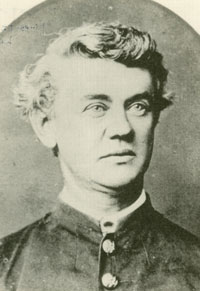
Captain Frederick W. (1834-1898), Commanding a battalion (Companies D, H and K) at the battle.
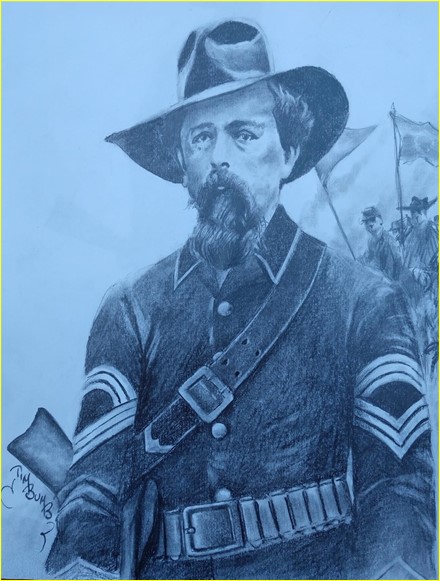
Sergeant Major William H. Sharrow (Courtesy of Tim Bumb).
- McCurry participated in the hilltop fight at the Little Bighorn where he received a gunshot wound in his left shoulder on the second day of the battle but remained in the field. On 1 August 1876 he was transferred the Non-commissioned Staff appointed sergeant major to replace British-born William H. Sharrow7 who had been killed with Custer.
- Due to one member of the team being killed6 and four wounded, including McCurry,7 the Benteen Base Ball Club never played another game after the Little Bighorn.
- McCurry has been suspected as the author of the notorious Reno petition, because of a perceived similarity of his handwriting with that of several of the alleged signatures, although the evidence is far from conclusive.
- On 2 October 1876, for his own reasons, McCurry reverted to 1st sergeant from sergeant major. He was discharged by expiration of service on 22 January 1877, at Fort Rice, as a 1st sergeant of excellent character.
- Contrary to what was originally published by Kenneth Hammer, and perpetuated by subsequent generations of authors, McCurry did NOT live at 4820 Oliver Street, Philadelphia, but [according to the United States Census, 1880] he WAS a boarder in the house of Harry Stafford, 1946 North 10th Street, Philadelphia, working in a carriage factory. He died, unmarried, of phthisis pulmonalis (TB) on 20 August 1883 in Philadelphia – address given as 1946 North 10th Street – and buried three days later in the city’s Cathedral Cemetery.9 The plot number is not known.
- Joseph McCurry’s age is shown as 27 in the 1880 census and 30 in the Philadelphia death records, which makes it seem very probable that he did, indeed, increase his age by two, or possibly three, years at enlistment to meet the minimum age requirement, i.e., 21. Writing in early 1876, Theodore Ewert gives McCurry’s age as 23, which supports the hypothesis that he was born in 1853, NOT 1850, as is published in two of the four books featured above.
- Notes and Sources
- 1. Theodore Ewert, originally from Prussia, author of Private Theodore Ewert’s diary of the Black Hills expedition of 1874, was discharged at Fort Rice with the rank of sergeant on 10 February 1876. He enlisted in the 5th Infantry on 15 February 1878 and discharged five years later at Fort Keogh, Montana Territory, a sergeant major of excellent character. He died 27 November 1906 at Quincy, Illinois.
- 2. Farrier John M. Marshall, Company H, who claimed to have been born in Scarborough, Yorkshire, though his true identity has not been verified, was absent sick in the post hospital, Fort Rice, on 5 May 1876 and he did not participate in the Little Bighorn campaign.
- 3. Private Alonzo Plumb was described by Ewert – ‘as “right field, the funnyman,” don’t profess to play base ball, but thinks he can keep the “nine” in a good humorous vein, thus in good working condition. He is from Ohio, catches pretty fair, is ambitious, but says himself that baseball is not “his forte,” but is on hand when “the laugh comes ”’ He was discharged April 3, 1876, at Fort Rice. He later served in the 1st and 10th U.S. Infantry, and discharged on disability in Washington, D.C. on 13 February 1891. Sadly, Plumb died, age 43, in an asylum for the insane on March 1, 1893 and buried in Saint Elizabeths Hospital East Cemetery, Washington, D.C., where a small military-style headstone marks the spot.
- 4. Lieutenant Thomas Mower McDougall, born Fort Crawford, WI, Company E, 7th Cavalry. He was appointed captain on 18 February 1876 and assumed command of Company B, which provided the pack train escort at Little Bighorn.
- 5. Real name Jacob Henry Gebhart, a private, Company M, from Altoona, Pennsylvania, killed in the hilltop fight at the Battle of the Little Bighorn, 26 June 1876.
- 6. Private Thomas E. Meador (correct spelling), Company H, from Bedford County, Virginia, also killed in hilltop fight, 26 June 1876.
- 7. Sergeant Major William Hunter Sharrow, born 2 March 1845, Sheriff Hutton, Yorkshire, England.
- 8. Private William Davis, from Vandalia, Illinois, Company E, killed with Custer’s column.
- 9. All Company H, 7th (i) 1st Sergeant Joseph McCurry, see above; (ii) Corporal Alexander B. Bishop, from Brooklyn, New York, wounded in right arm in the hilltop fight, and taken on the steamer Far West to Fort Lincoln; (iii) Private Charles H. Bishop, from Washington, D.C., wounded in the right shoulder but remained in the field; (iv) Private William C. “Fatty” Williams, born Wheeling, Virginia, wounded in the left leg, also remained in the field.
- 10. Pennsylvania, Philadelphia City Death Certificates, 1803-1915.
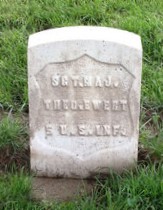
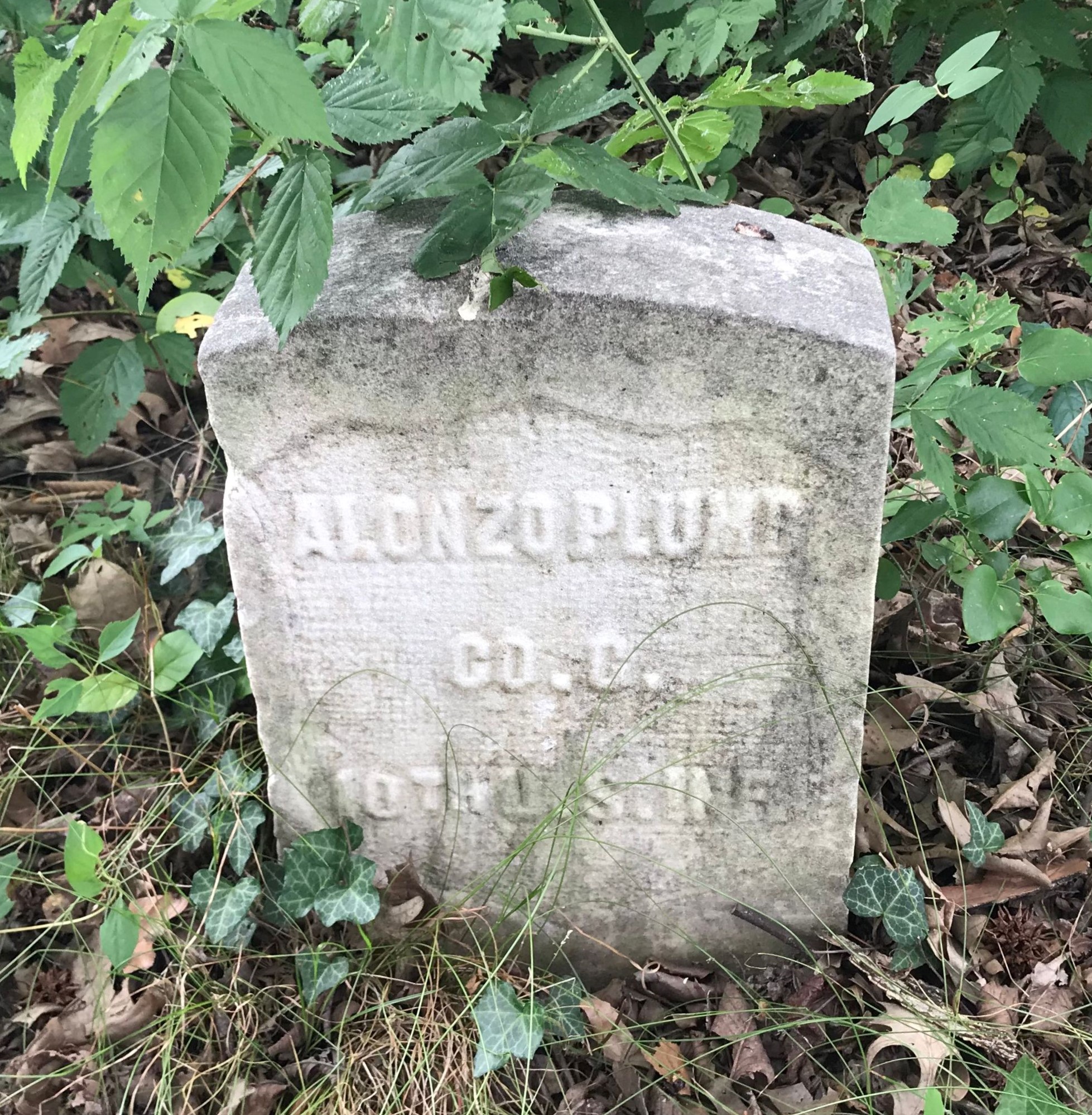
(Above)Headstone of Private Alonzo Plumb. (Left) Headstone of Sgt Maj. Theodore Ewert.
- Obituary – Theodore Ewert – 27 November 1906 (11 March 1847-27 November 1906)
- Colonel Theodore Ewert, who served in the civil war and later in the regular army, and who was for twenty years connected with the Illinois National guard, died Wednesday morning at the Illinois Soldiers’ and Sailors’ Home at Quincy, of which he had been an inmate since last spring. The funeral will take place at the cemetery of the home this afternoon, and the interment will be at the cemetery of the home. The services will be under the auspices of the Grand Army of the Republic. Colonel Ewert died as the result of a general breaking down of his mental faculties and the system in general. He was 64 years old.Colonel Ewert was a native of Prussia, but came to this country when a youth. On Aug. 9, 1861, he enlisted in Thielman’s cavalry, and re-enlisted Feb. 14, 1864. He was commissioned second lieutenant of the Twelfth United States colored heavy artillery on July 9, 1864, and was mustered out April 11, 1865, at the end of the war. Jan. 24, 1867, he enlisted in company H of the Thirty-sixth United States infantry and was discharged as corporal Jan. 24, 1869. He again enlisted, this time in the seventh United States cavalry, April 1, 1871, and was discharged as sergeant April 10, 1876. April 15, 1878, he enlisted in the Fifth United States artillery, and was discharged as sergeant major April 14, 1883.
- Colonel Ewert on his discharge from the army in 1883, came to Springfield and was appointed a clerk in the office of the adjutant general. Aug. 30, 1883, he was commissioned captain of Troop C, First cavalry, Illinois National Guard. He resigned Oct. 10, 1884, to accept the position of captain and adjutant of the Eighth Infantry, I. N. G., being commissioned as such Oct. 18, 1883, to rank from April 30, 1883.
- March 15, 1885, he was commissioned as acting assistant adjutant general and on July 1, 1885, as assistant adjutant general with rank of colonel, serving until his successor was appointed in June, 1889. Dec. 30, 1889, he was commissioned as captain of Company C, Fifth Infantry, resigning May 16, 1890. May 4, 1891, he was appointed assistant adjutant general of the Second brigade, with the rank of lieutenant colonel. He resigned this position Oct. 4, 1892. All this time he was connected with the adjutant general’s office, remaining there until the accession of General Alfred Orendorff as adjutant general in the spring of 1893. He was commissioned Captain and adjutant of the Fifth Infantry, July 14, 1896, holding the position until April 19, 1902, when he was appointed assistant adjutant general, holding that position until General Scott was appointed adjutant general in 1905, when he became custodian of the state arsenal. When his health failed last spring, he was sent to the Illinois Soldiers’ and Sailors’ Home at Quincy.
- Colonel Ewert was twice married. His first wife died several years ago, and he married Miss Nellie Bell, daughter of Colonel John C. Bell of this city, who survives him, together with one son, Frederick Ewert, now residing in Chicago and one daughter, Miss Etelka Ewert, both children by his first wife. Colonel Ewert was a member of the G. A. R. and of the Modern Woodmen of America. Pub. in the Illinois State Register, Springfield, IL 12-4-1906.
[2] A Seventh Cavalry Scandal by Stephen E. Osman
- This story dates to just after the Civil War and is the result of an interesting research project. Recently I found a stack of stereo cards in a house clean out. Stereos were paired images mounted on a card and used with an inexpensive, adjustable hand-held viewer. They gave the viewer a realistic 3D impression and were popular state of the art graphics through the Civil War and for years after. Many of the cards I found were early views of the Badlands and out to Colorado, some part of a series of Northern Pacific Views taken by their official photographer F. Jay Haynes. Several of these were clearly military subjects, but minimally identified in pencil.
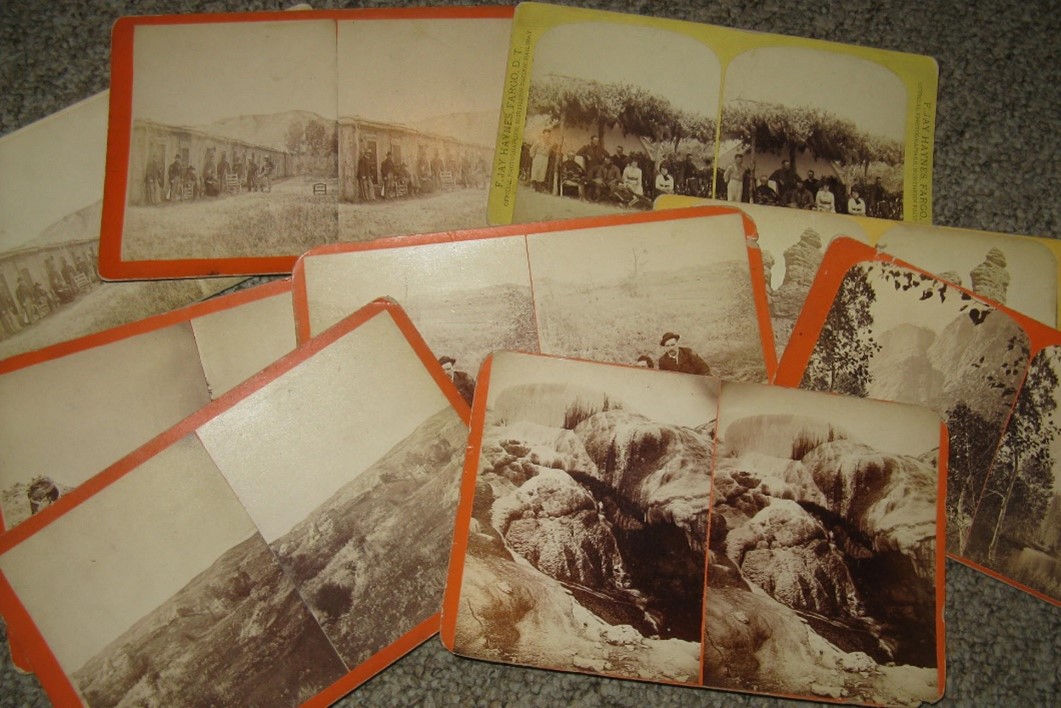
A selection of stereo cards produced by F. Jay Haynes.
- In the wake of the Great Sioux War, the army provided guards for construction of the Northern Pacific Railroad through the Badlands between 1879 and 1882. The area was part of the vast and sparsely settled Department of Dakota, headquartered at Fort Snelling. Various small company sized units of cavalry and infantry rotated through several forts and short-term summer cantonments as the Northern Pacific Railroad worked its way west. In the wake of the 1876 destruction of several companies of the 7th US Cavalry under Custer, the replenished regiment formed part of those summer guard details.
- One of the stereo cards shows temporary quarters for officers. The half dozen officers, small number of quarters and ramshackle appearance eliminated most of the better built and documented army posts of around 1880. One post that did match had a lifespan of only 1879 to 1882 and quarters for only one or two companies. But no photographs could be found in an internet search. Cantonment Badlands, near the crossing of the Little Missouri River outside modern Medora, North Dakota, was the most likely candidate and the terrain seemed to match. A friend who’s a top Indian Wars historian and author confirmed the presumption that this was indeed Cantonment Badlands, used as a base camp and supply depot for the railroad construction guard details further west.
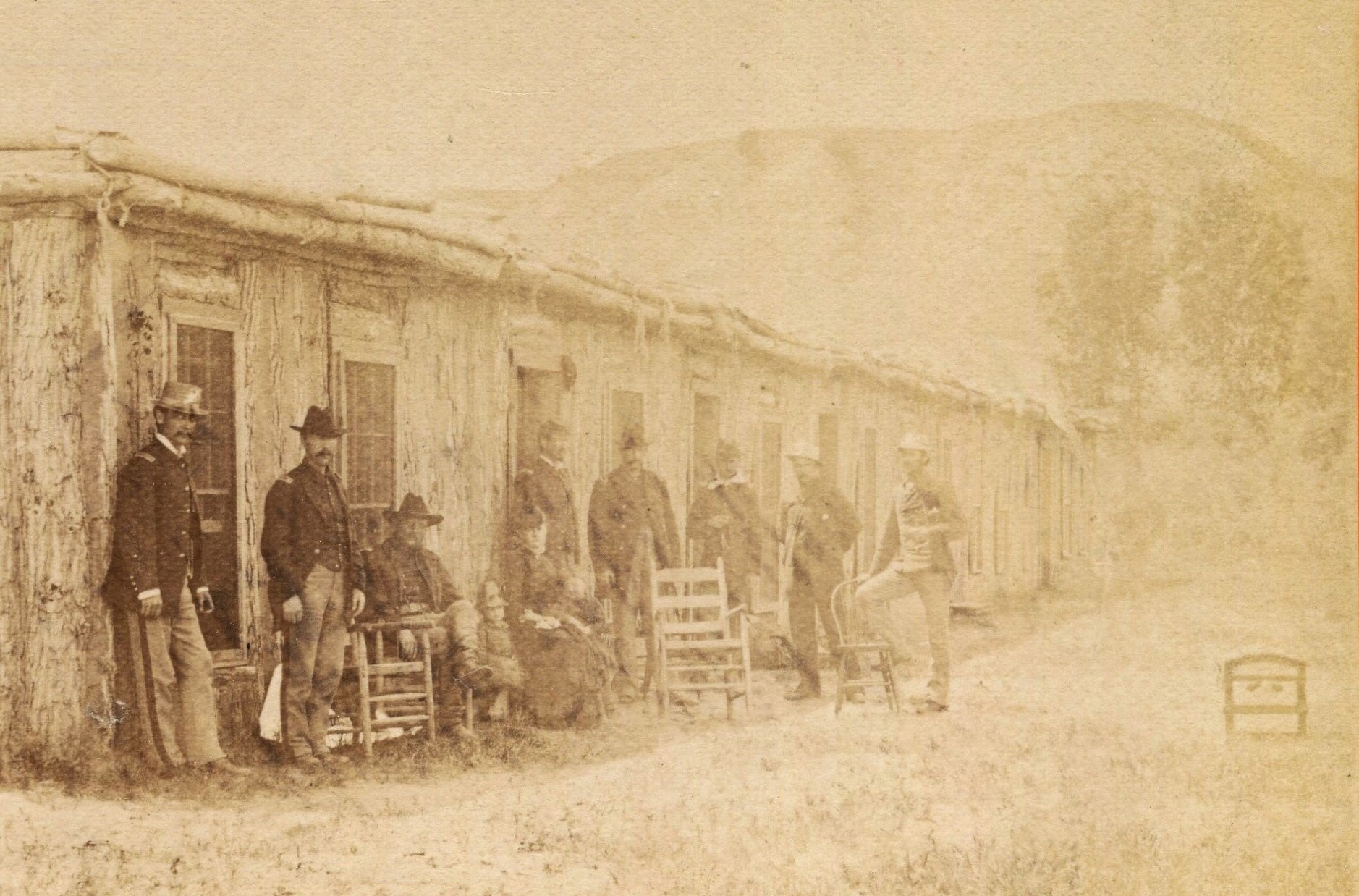
- In charge of one of the 1880 guard details was Captain James Montgomery Bell. He had commanded a Pennsylvania cavalry company through many Civil War battles before moving to the regular army in 1866. Fortunately, on detached service during the Custer Battle, Lieutenant Bell was promoted captain of Company F following the death of its Captain George Yates in that action. Bell continued to serve a long career, retiring as a brigadier general in 1901. He was even under consideration for a Medal of Honor at his death.
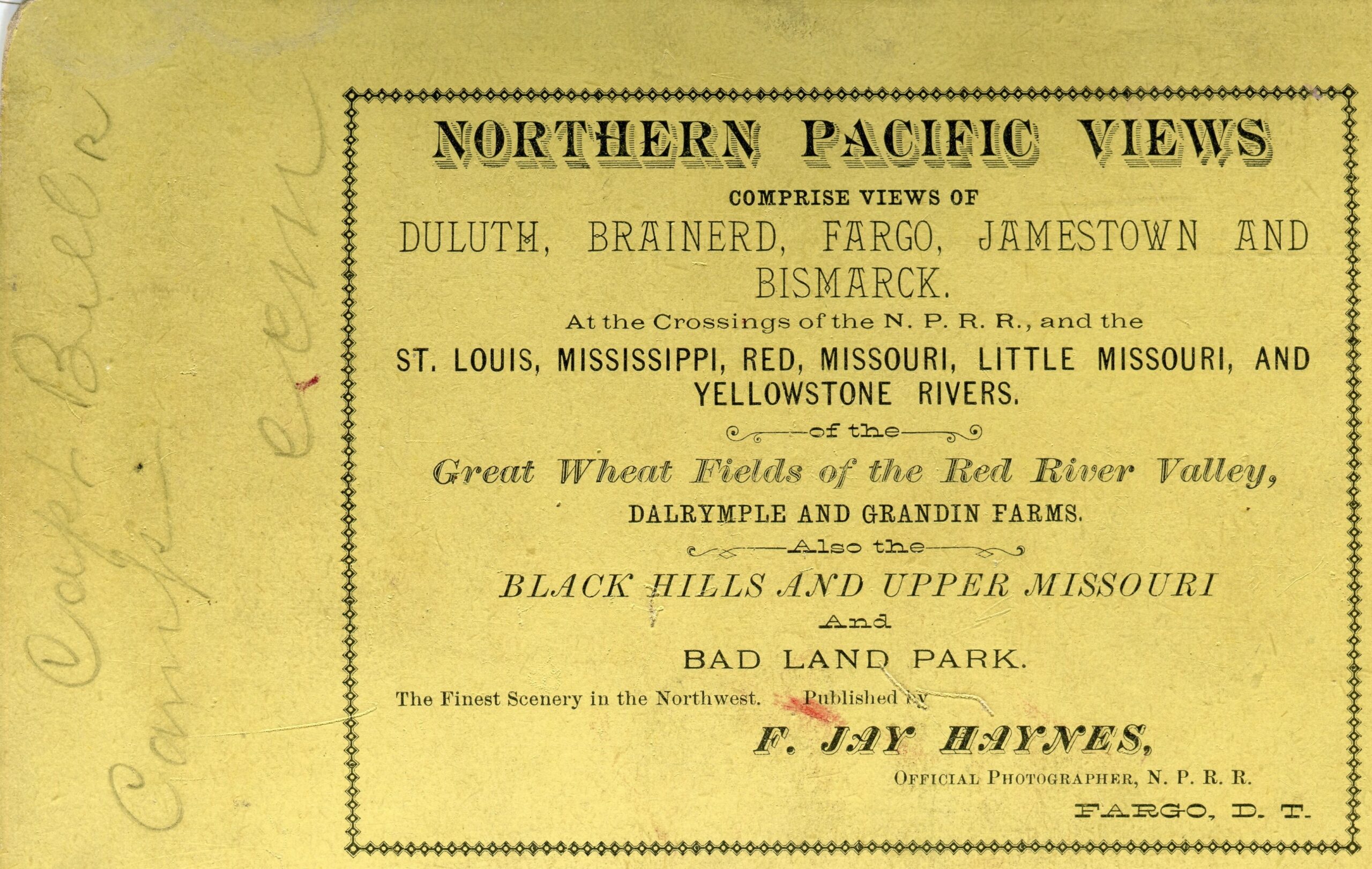
Taken from the back of the stereo card of Bell's camp with "Capt Bells Camp" written in pencil.
- A second photo shows a group of variously clad officers and civilians in front of a conical Sibley tent shaded with a brush bower. The only identification was a pencil note Capt Bell’s Camp on the reverse. I looked through officers named “Bell” in Heitman’s Historical Register and Dictionary of the U.S. Army; only one officer had service and rank in the area and time of the photograph. James M. Bell is striking a jaunty pose just left of center. Identifying the others in the photo is an ongoing and challenging research project.
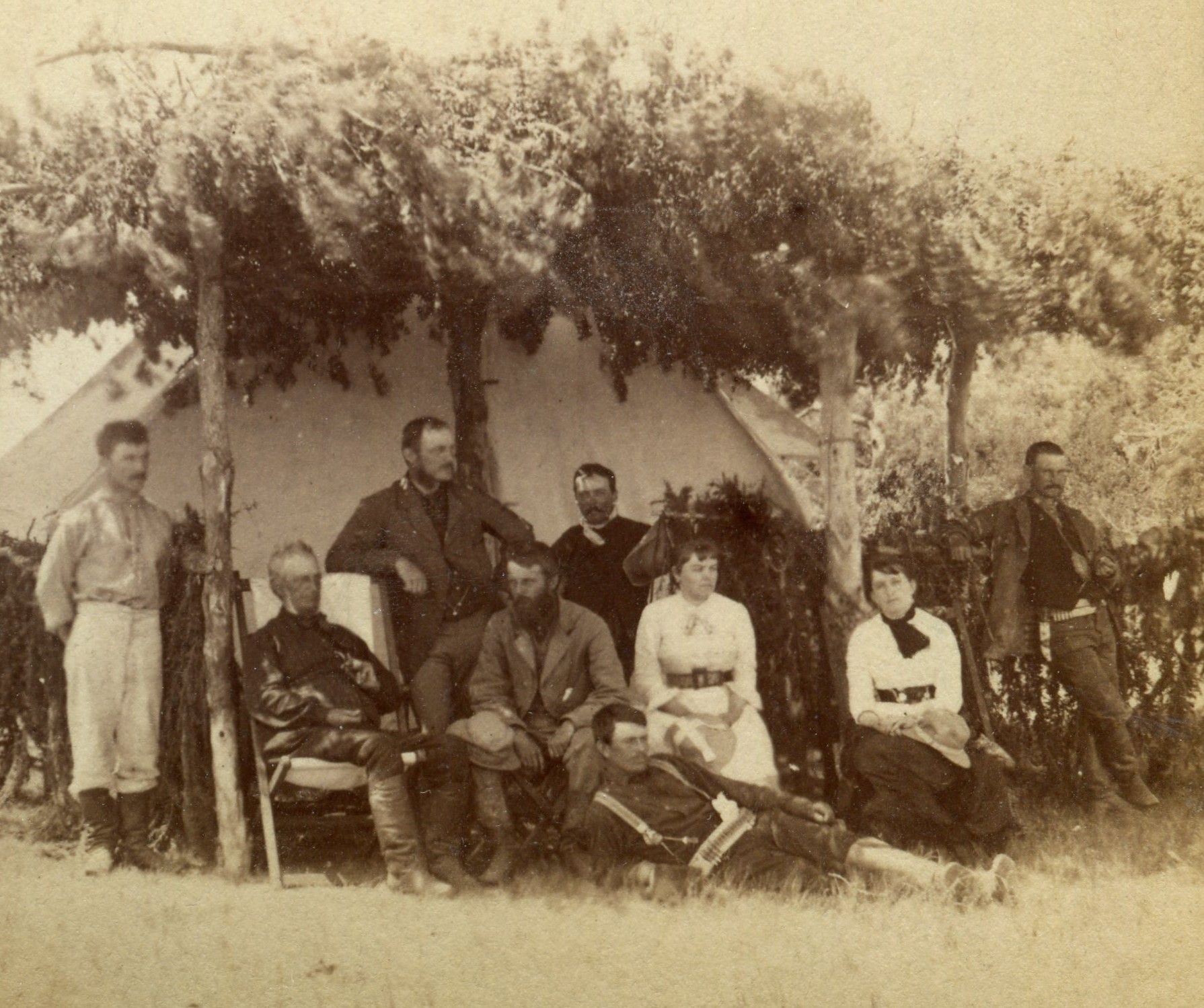
Captain William M. Bell's Camp at Cantonment Badlands, 1880. Capt Bell, standing 2nd from left, Emily Hones Bell, seated on right. (Photograph by F. Jay. Haynes)
- The third stereo card turned out to be a long-distance view of this same encampment with the soldiers of Company F, 7th Cavalry “standing to horse” in their shirt sleeves in the Dakota heat. The Civil War surplus tents behind them each slept a dozen or so men, with one or two reserved for the officers. Perhaps the ladies stayed in the smaller wall tent to the right. This picture is labeled as having been taken at Sentinel Butte, near the modern town of the same name and close to the route of the Northern Pacific Railroad construction had reached that vicinity in 1880, and the troops spent the summer patrolling from that temporary encampment.
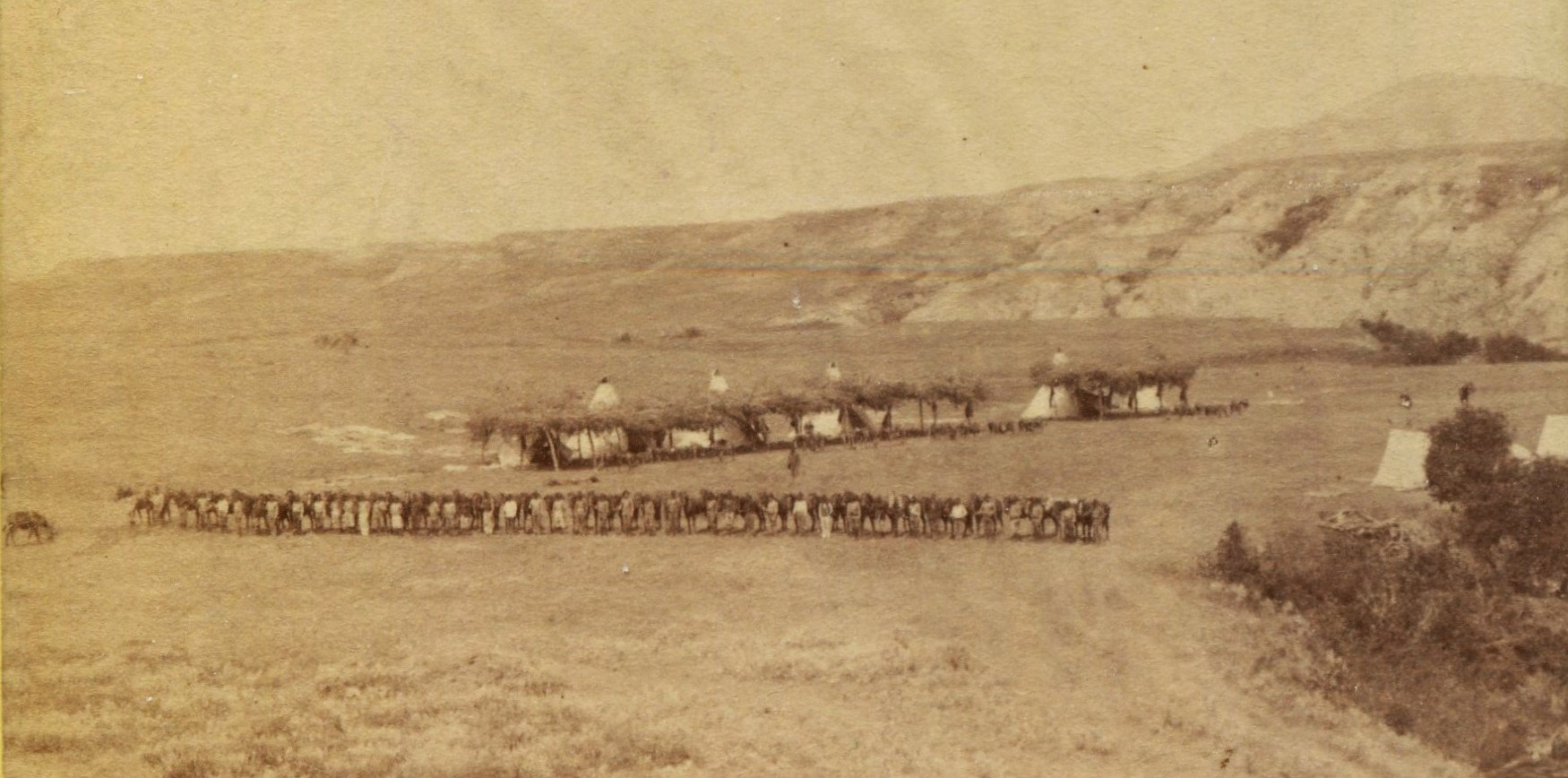
- But back to Captain Bell and what turned out to be an intriguing story. The captain had taken a 21-year-old wife, some 13 years his junior, in 1872. English born Emily Mary Hones, youngest of the family, emigrated in 1857. Her father, soon to be widowed, quickly married their young, live-in servant girl and continued to add to the family. Emily, by newspaper accounts “a woman of more than ordinary beauty” and quite vivacious, was probably happy to leave home with the dashing Lieutenant Bell. He had a reputation as one of the army’s best recruiters, and his Company F was known as the “band box company” thanks to its always sharp uniforms. But just a few years later Emily Bell would be embroiled in a controversial St. Paul court martial of her husband’s post commander at Fort Abercrombie, 41-year-old widower Marcus Reno.
- Emily had followed her husband through various postings in the west, trying to make a home in the always rough and ready officers’ quarters at a number of forts. By 1876 this was Fort Abercrombie on the Red River on the northwest border of Minnesota. Captain Bell was on an emergency leave over the Christmas holidays attending an ailing father back east. Emily remained with the small, closed military officer community on post. Petty jealousies, gossip, rumor and vindictiveness was rampant in the old army. A minister visiting Fort Abercrombie was invited to stay in the Bell’s quarters, and this set Reno off and led to his court martial. Reno (pictured on right) was already a controversial figure with few defenders after his questionable conduct on the Little Big Horn. His career would be forever tarnished and eventually shortened by the Battle and his own personal behavior.
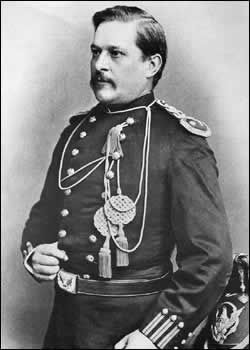
Major Marcus A. Reno.
- “Conduct Unbecoming an Officer and a Gentleman,” each charge with specifications. The first specification of the first charge was that Reno took “improper and insulting liberties with the wife of the said Captain Bell, by taking both her hands in his own, and attempting to draw her person close to his own. This to the scandal and disgrace of the military service, at Fort Abercrombie, Dakota, on or about the 18th day of December 1876.” The second specification was similar. Other specifications resulted from Reno’s vindictiveness about the minister continuing to stay at the Bell’s quarters, and Emily’s refusal to invite him, post commander, to a New Year’s party attended by all the other officers and wives – a serious and very pointed social snub.
- Several of Reno’s statements to others on post seriously impugned the reputation of Mrs. Bell; and testimony at the court martial seemed to indicate they had some common knowledge, if not validity. Still, a commanding officer by the social customs of the army, had absolutely no place in verbalizing opinions about the wife of a subaltern officer. The five additional specifications to the first charge dealt with Reno’s purported statements about Emily’s character, such as “it is like a spoiled egg, you cannot hurt it…” He even threated to cancel a post church service if Mrs. Bell was allowed to play the organ as she had previously. The specification of the second charge was that Major Reno had attempted to bribe the Bell’s African American servant into giving him favorable testimony. The court convened for a week and eventually convicted Reno of the first charge and most of its specifications but failed to prove that he had said that “Mrs. Bell ought to know better than to make a fight with me; her character is too vulnerable, or words to that effect.” Major Reno was found not guilty of the second “conduct unbecoming” charge and its specification of witness tampering. The court sentenced him to be dismissed from the service. But President Harrison, himself a former Civil War officer, reduced the sentence to two years suspension without pay based on Reno’s previous 19 years of active service. The Secretary of War sternly wrote “Major Reno’s conduct towards the wife of an absent officer, and in using the whole force of his power as commanding officer of the post to gratify his resentment against her, cannot be too strongly condemned…”
- Just two years later Reno was again in court on the same “conduct unbecoming” charges, with specifications of drunkenness, assault and even window peeping. This time he was dismissed from the service for good. His sad tale was much discussed at the time and has generated many articles and a couple of books to the present day. The Bells remained married, though rumors of Emily’s questionable character continued. She finally passed in 1940 at age 89 and what changes she must have seen in her lifetime.
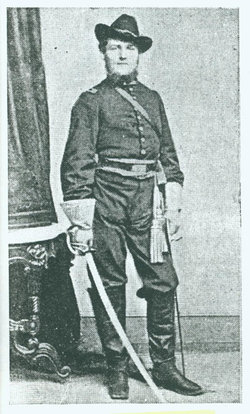
Lt William M. Bell, ca. 1870.
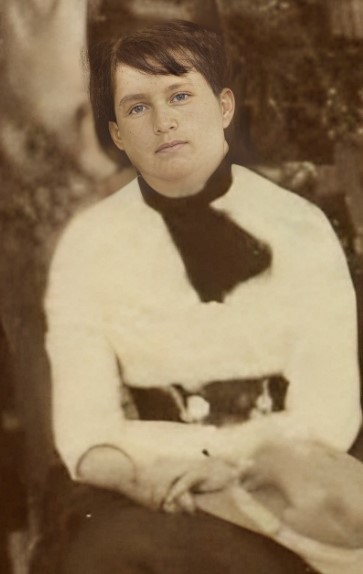
An enlarged and enhanced image of 29-year-old Emily Hones Bell, 1880, from the group photograph (above) by F. Jay Haynes.
- So now the mystery: Is the attractive young woman on the right photographed in Captain Bell’s camp (above) his wife Emily? Both women at that remote camp had to have been associated with the officers in the picture, and it seems unlikely one would not be the commanding officer’s 29-year-old wife. Secondary sources on the Reno/Mrs. Bell affair state that no photographs of Emily Mary Hones Bell exist. I firmly believe one just surfaced out of a Richfield, Minnesota basement!
[3] Emily Mary Hones - Wife of Captain James Montgomery Bell

94 King's Road (formerly 11 Colvill Terrace), Chelsea. Emily Mary Hones was born here. (Author's photograph, 12 March 2018.)
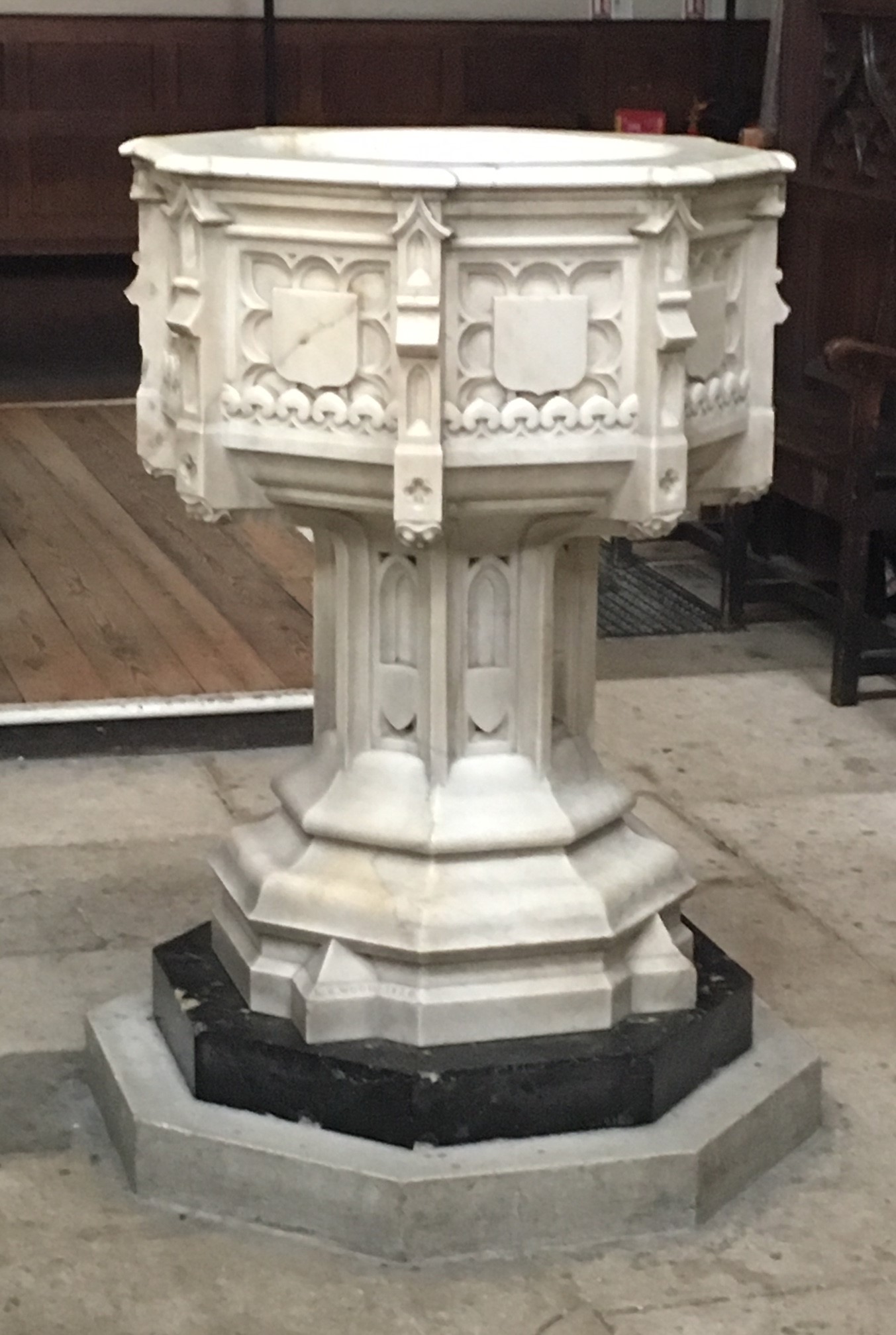
Emily Mary Hones was baptised at this font (dates from 1826), in St Luke's Church, Chelsea. (Author's photograph, 12 March 2018.)
- A Woman “of more than ordinary beauty”
- Emily Hones Bell guaranteed her place in American military history as the victim of ‘inappropriate behaviour’ by a predatory post commander at Fort Abercrombie, Dakota Territory, in December 1876. Found guilty on seven of the eight charges filed against him, the much-maligned major was sentenced to be dismissed from the Army though, shortly after, this seemingly harsh sentence was reduced to suspension from rank and pay for two years with effect from 1 May 1877.
- This writer is neither qualified nor inclined to pass moral judgement of his fellow countrywoman but is prepared to accept that there may have been times when this slender, dark-haired 25-year-old, described by the contemporary press as “of more than ordinary beauty and … of a vivacious disposition,” acted in an extrovert and over familiar manner. It should be borne in mind that this event took place in the last quarter of the nineteenth century when rigid Victorian values were far different from those we enjoy today.
- Emily Mary Hones, the fourth and youngest child of Thomas Maskell Hones, a fishmonger, and Sarah Ball Hones, was born at 11 Colvill Terrace, on the fashionable King’s Road, Chelsea, London, England on 12 March 1851. Together with her older sister, Sarah Frances, Emily was baptised by the Rev. Richard Lediard, at the parish church of St Luke, on 27 March 1853.
- In 1851, Thomas Hones had filed for bankruptcy and at some unknown date decided to seek a better life for his family in America. It must be assumed that he travelled ahead of his wife, four children and sister-in-law, Emma Ball, who arrived in New York from London on 1 June 1857 aboard the sailing ship Mary Bradford.
- The family most likely remained in New York until Thomas found work as a brewer in Portsmouth, New Hampshire. The Honeses lived at 61 Islington Street and this strongly suggests that he was employed at the famous Frank Jones Brewery which, in 1858, had moved into the city to start producing ale.
- Sarah Ball Hones succumbed to ‘dropsy’, an old name for edema, on 14 December 1860 and was buried in Harmony Grove Cemetery, Portsmouth. However, her bereaved husband’s grief appears to have been short-lived as he lost no time in ‘tying the knot’ with the family’s young, live-in servant, Mary Kennedy from Scotland, who before the following year was out had presented him with a third son whom they called William.
- Inland Revenue Service Tax Assessment records for the second half of the 1860s indicate that Thomas Hones, a brewer, was earning $1,100 a year on which he paid tax of $25, i.e., five per cent on all income exceeding $600.
- In 1870, Sarah Frances Hones married Edward Vern Jewell, a captain in the 146th New York Infantry during the Civil War, and the newly-weds set up home in Manhattan, New York, though Emily’s whereabouts during this period remain obscure. We do know that on 12 March 1872, her twenty-first birthday, at the Trinity Church, Pittsburgh, Pennsylvania, Emily married First Lieutenant James Montgomery Bell, thirteen years her senior, who was “considered one of the greatest recruiting officers in military history.” A marriage that was to remain childless. Emily’s father died on 17 December the same year and was laid to rest beside her mother in Harmony Grove Cemetery (no headstone).
- Lieutenant Bell, on leave at the time of the Battle of the Little Bighorn and one of the three officers so derisorily called “Coffee Coolers” by Captain Frederick W. Benteen, was promoted to the rank of captain with effect from June 25 June 1876 to succeed George Yates as commander of Company F.
- The regrettable affair at Fort Abercrombie, referred to above, unfolded over the Christmas Holiday 1876 while Captain Bell was away from the post visiting his sick father in Philadelphia. Major Marcus A. Reno was charged on no less than eight counts, two of which related to his making improper advances to a subordinate officer’s wife. Another said Reno threatened Mrs Bell after she had not invited him, the garrison commander, to a social gathering. Four others recite instances in which the major slandered Mrs Bell to Rev. Richard Wainwright, the chaplain, and others, injurious to her character and, also, accused Reno of falsely quoting fellow officers’ involvement with Mrs Bell. The eighth charge was he gave orders that she should not play the organ at church and sent her a message containing a threat that if she were allowed to play, he would stop the service.
- The prosecution provided damning evidence sustaining each charge, while the defence offered little in the way of evidence and the accused was not even allowed to testify or produce witnesses against Mrs Bell’s character. Almost inevitably, Reno was found guilty and temporarily dismissed from the service.* There were, however, at least some who felt it would have been far better if Mrs Bell had kept her own secrets and borne the insults and smears in silence.
- The fact that Mrs Bell regularly played the organ at garrison church services and was “a general favourite with the officers and their wives” may have been sufficient reason for a resentful Benteen to speak ill of her, much in the same way as his well-documented, disparaging remarks about another beautiful and well-liked army wife forever closely associated with the Seventh Cavalry, namely, Elizabeth Bacon Custer.
- Captain Bell was brevetted lieutenant colonel for gallantry against the Nez Perce at Canyon Creek, Montana in 1877; participated in the surrender of Chief Gall’s band of Sioux at Poplar Creek, also in Montana, in 1881; served as escort for the construction crews of the Northern Pacific Railroad in the summers of 1880-82; saw action in Cuba and the Philippines in 1899-1901; and retired from the army with the rank of brigadier general in 1901.
- In 1910 the Bells were living in New London, Connecticut while ships’ passenger lists reveal them arriving in San Francisco, California, from Yokohama, Japan, aboard the S.S. Korea on 19 May 1913, and in New York from Rotterdam, Holland, on the S.S. Potsdam on 5 September 1914, just one month and a day after Great Britain declared war on Germany.
- In a letter to Elizabeth Custer from Cookstown, New Jersey, dated 15 December 1918, Brigadier General Edward S. Godfrey [a first lieutenant at Little Bighorn] wrote: “I had a letter from Gen. J.M. Bell, Pasadena, Calif., the other day. He is 81, and in fairly good health. Mrs. Bell was in hospital for operation for bladder troubles, he expects her to be out in several weeks.” It is assumed that the patient made a full recovery as she lived for another twenty-one years!
- James Bell died in Hermosa Beach, California on 17 September 1919 and was interred in San Francisco National Cemetery. Emily, who shared her home with her half-brother, William, a clerk in the Office of the Paymaster-General for over twenty years, returned to Pasadena. William Hones died 23 August 1933 and his mortal remains were taken back to Portland, New Hampshire, to be laid to rest in the family plot in Harmony Grove Cemetery.
- Emily (also spelled ‘Emilie’) Mary Hones Bell, long since a naturalised American citizen, died at Hermosa Beach, California, on 1 June 1940, from hypostatic pneumonia; she was 89 years old. After cremation, her ashes were placed in her husband’s grave where a fine cross-shaped, granite monument was erected in their memory to mark the spot.
- As far as this writer is aware, no photograph or other image of Emily is known to exist.
- Note (*): Clearly Reno did not learn his lesson. On 24 November 1879, at Fort Meade, Dakota Territory, he was court-martialled for conduct “unbecoming an officer” and dismissed from the service on 1 May 1880. This was changed to an “honourable discharge” in 1967.
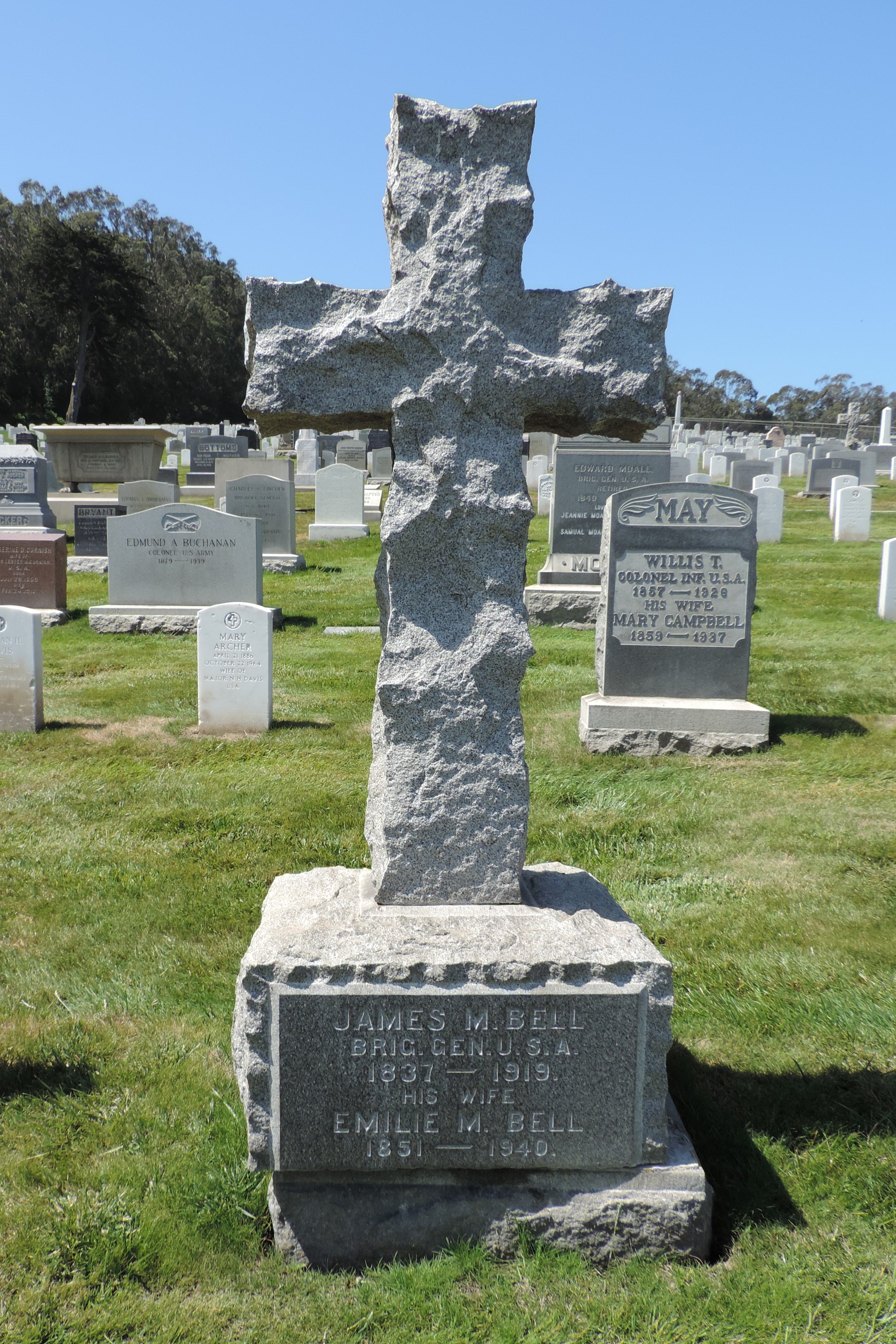
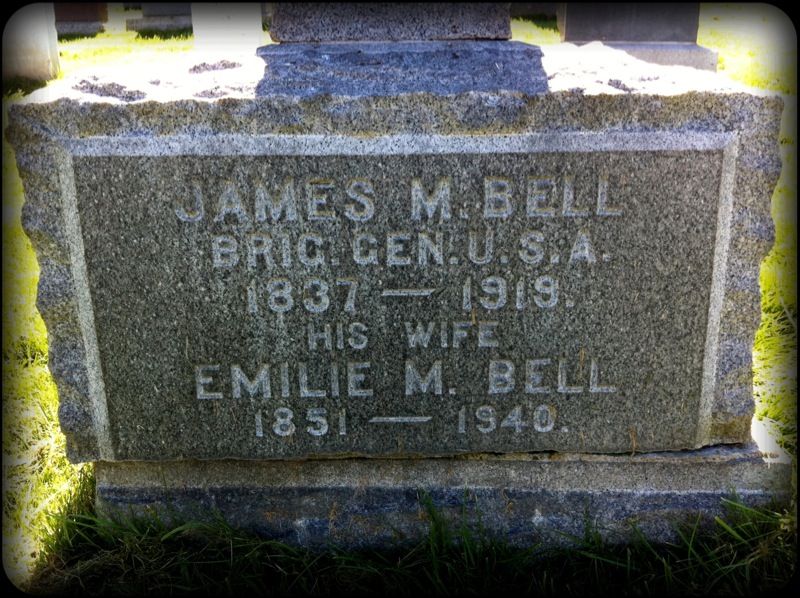
The gravestone, left, and inscription, above, erected in memory of James Montgomery Bell and, his wife, Emilie (Emily) Mary Hones Bell, San Francisco National Cemetery - Memorial ID 58852658.
- We remember two members of Custer’s 7th U.S. Cavalry on 25 June 1876 who died on 13 November, 1881 and 1905 respectively.
- Private Patrick Coakley (real name Patrick Redican), Company K – A son of the Emerald Isle
- Patrick Coakley claimed to be 24 years of age when he enlisted in the U.S. Army in Chicago on 26 December 1866, although he actual date of birth has never been verified. Kenneth Hammer incorrectly transcribed Coakley’s place of birth in the U.S. Army, Register of Enlistments, i.e., ‘Kings Co’,1 as ‘Kingscourt’, which in turn has been further corrupted to Kingscourt, County Cavan.
- Most biographies have him on detached duty as orderly to Brigadier General Alfred H. Terry, commander of the Dakota Column, but this is challenged by Vern Smalley2 who shows him with his company in the hilltop fight during the battle. Patrick Coakley, who married Bridget McGuire in 1877 when he gave his real name of Redican, died age 39, on 13 November 1881, of gastritis from intemperance and haemotosis in Barnes Hospital, U.S. Soldiers’ Home, Washington, D.C. He is buried in the National Cemetery there where a small weathered headstone marks the spot. His widow received a pension of $12 a month until her death on 14 May 1923.
- Note: King’s County has since been renamed County Offaly.
- Participants in the Battle of the Little Big Horn, Frederic C. Wagner III, McFarland & Company, Inc., Jefferson, NC, 2016, p. 26.
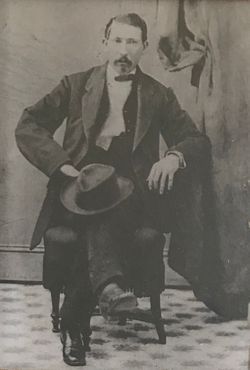
Daniel Coakley (Date unknown).
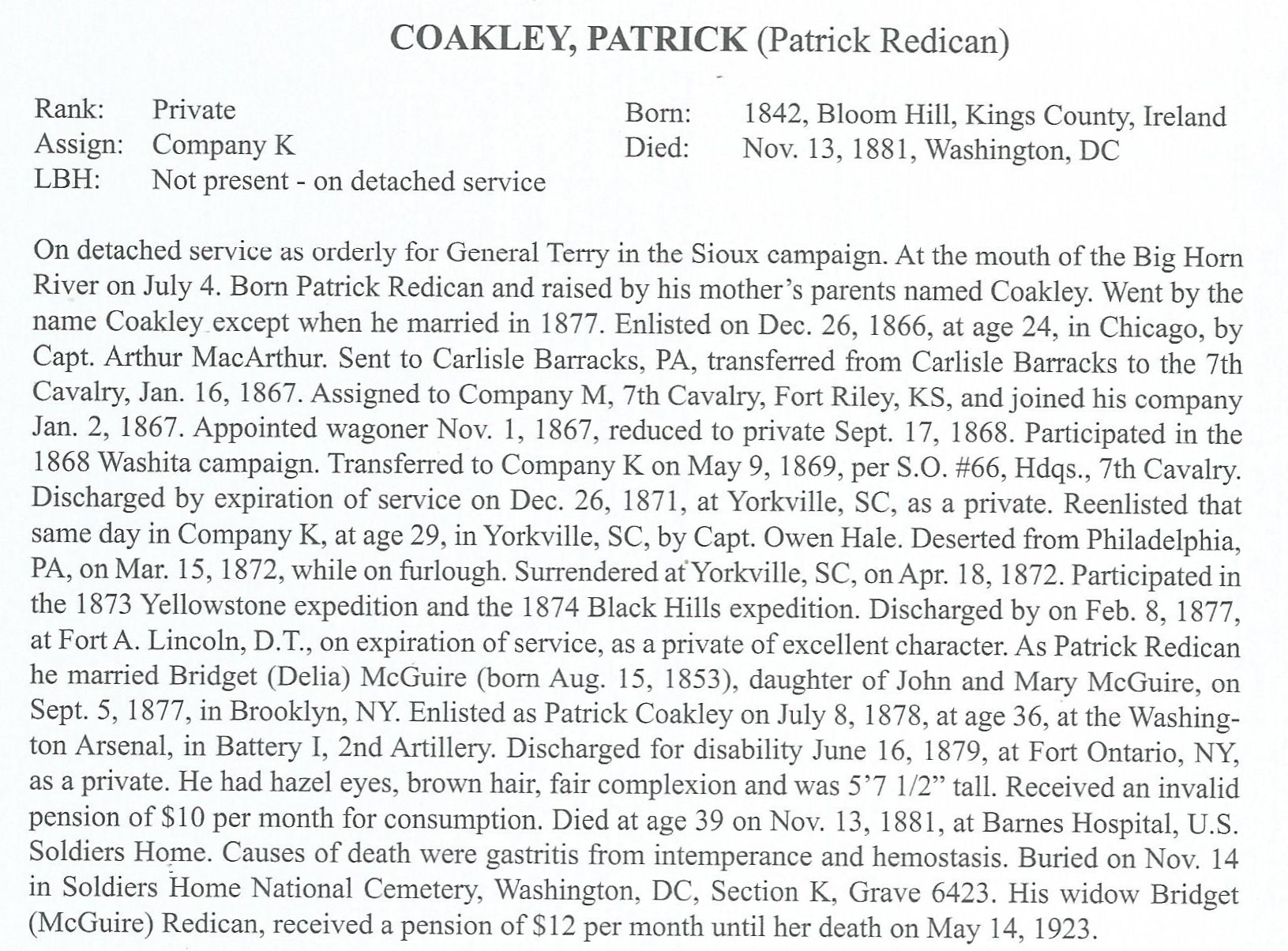
'Men With Custer - Biographies of the 7th Cavalry', Edited by Ronald H. Nichols with Daniel I. Bird, CBHMA Inc., 2010, p. 72.
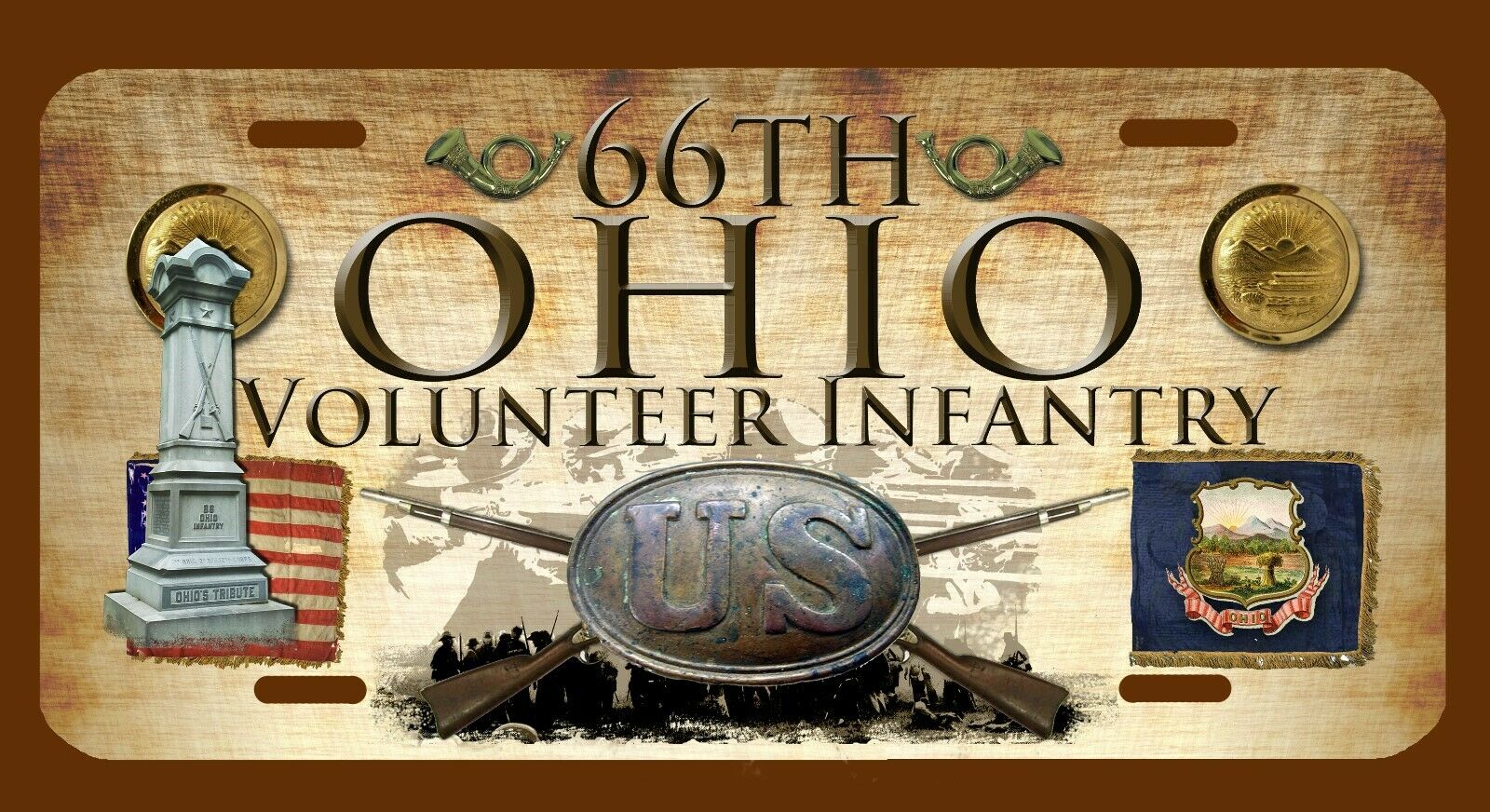
- Sergeant Thomas Morton (real name Thomas H. Rush), Company D – A member of John M. Birge’s elite Western Sharpshooters.
- Thomas H. Rush, grandson of Henry Rush and Rachel Creviston, was born 19 November 1841 in Greenville, Darke County, Ohio. The Federal Census (1850) shows him as eight years old living with his uncle, Morris Bryson, whose half-brother, Thomas Rush (presumbly the young Thomas’ father who had died 1841), was the first white child in that county.
- On 21 April 1858, just under six months short of his 17th birthday, Rush enlisted in the U.S. Army and was assigned to Company I, 5th Infantry but was discharged at Fort Stanton, New Mexico, as a private, on 9 April 1861, because of his minority enlistment. Undeterred, on 15 September 1861, he enlisted in Company D, Birge’s Western Sharpshooters. Prospective members were required to shoot from a standing position and place ten shots in a three-inch group at 200 yards. This elite band of men were issued with a long-range Dimick hunting rifle and wore a distinctive squirrel’s tail dyed black in their grey felt caps. Company D was re-designated Company C, 14th Missouri Infantry in April 1862 and further re-designated Company C, 66th Illinois Infantry in January 1863. Rush was wounded twice during 1864 and ended the Civil War with the rank of captain.
- On 17 November 1866 Rush re-enlisted as a private under the name of Thomas Morton and assigned to Company C, 7th Cavalry. Having been a captain in the volunteer service he used the alias of Morton because he did not want family and friends to know he had accepted a lower rank. Rush blamed the poor condition of the barracks at Fort Lincoln for catching a bad cold during the severe winter of 1875-76. He was in the post hospital suffering from inflammation of the lungs from 17 March to 18 June 1876 and hence did not take part in the Little Bighorn campaign. Thomas Rush, who is reputed to have married an Indian woman, died age 63, on 13 November 1905, from pulmonary tuberulosis in Elmhurst, Alameda County, California. His place of burial is not known to this writer

A Dimick Hunting Rifle.
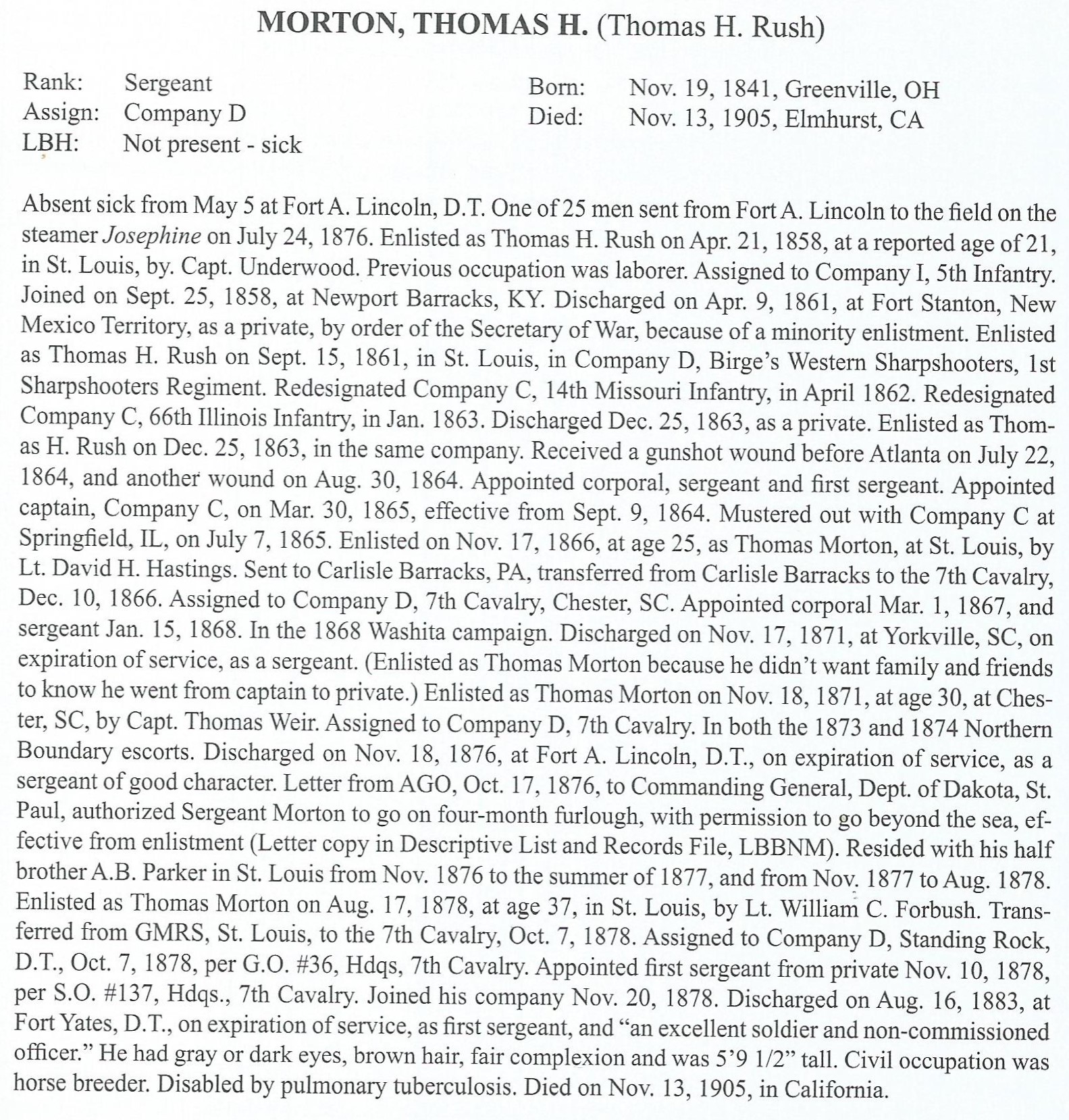
'Men With Custer - Biographies of the 7th Cavalry', Edited by Ronald H. Nichols with Daniel I. Bird, CBHMA Inc., 2010, p. 285.
Private James Pym, Company B, 7th U.S. Cavalry
- Question: What is the connection between Private James Pym, Co. B, 7th U.S. Cavalry, and the legendary Western Lawman, Jeff Milton?
- Answer: A memorialized .45 SAA Peacemaker.
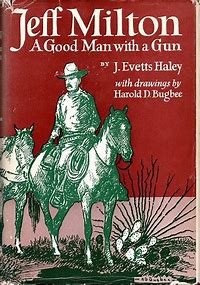
Published by University of Oklahoma Press, Norman, Oklahoma, 1948.
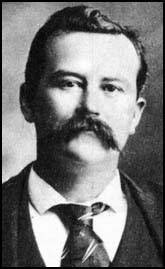
Jefferson Davis "Jeff" Milton (1861 - 1947).
- I have recently exchanged correspondence with firearms historian, Jim Fender, Madbury, New Hampshire, regarding this Colt .45 SAA Peacemaker, which is currently owned by David Trevallion, a British citizen living in the United States, who acquired the revolver over 50 years ago from a Jack Holliday whose family has a winter home near Tucson, Arizona. A neighbour of the Holliday family was Jeff Milton, a very important figure in law enforcement in the 1880s-1930s in the American Southwest. Apparently, Milton owned this Colt for many years and carried it in a holster strapped to the steering column of his Ford Model T. He gave the revolver to Holliday, who subsequently gifted the Colt to its present owner. That being said, it cannot be stated with any certainty that Pym actually possessed the Colt, or how it may have gone from a friend or heir of Pym’s to Jeff Milton.

Colt .45 SAA engraved with the name of James Pym Coy B. 7th U.S. Cavalry - (Photograph courtesy of David Trevallion)
- Pym does not seem like the type of person who would have purchased a Colt SAA and had the backstrap engraved with the commemorative language (nor does Jim believe he would have had the money to spend on such a commemorative revolver) – see illustration above. Colt factory records show that the revolver was shipped from the factory to a dealer in New York City in 1879. The inference is that during the period that Pym was a city marshal in Lake City, Minnesota, a group of civic-minded townspeople bought the revolver, had it engraved, and presented it to Pym, who is known to have worn his Medal of Honor with justifiable pride. Jim has been in contact with the Lake City Historical Association, and a person there has offered to search for references to Pym (there is the one reference in a newspaper that I have located about Pym departing Lake City hurriedly without paying outstanding debts). However, at the time of writing, Jim has not heard from the person to whom he spoke with any additional information.
- Watch this space for further developments.
- More information on this trooper from Garsington, near Oxford, who was shot dead by a young cowboy in Miles City, Montana, can be found on the Biographies page, number 50.
Sergeant Major William H. Sharrow, 7th U.S. Cavalry
- I am delighted that the talented artist, Tim Bumb, Mandan, North Dakota, has given me permission to publish his interpretation of Sergeant Major William H. Sharrow in campaign dress, based on a carte-de-visite courtesy of George Kush, Alberta, Canada. Many thanks to both.
- Two markers are placed north of Last Stand Hill adjacent to the walking trail to the Indian Memorial, one of which may be for Sharrow. Others say that his arrow-riddled body was discovered well over a mile away, beyond the Custer Battlefield Trading Post but north of the river, which begs the question “Was Sharrow carrying a message from Custer to General Terry?” Your comments would be most gratefully received.
- More information on Sharrow, from Sheriff Hutton, near York, can be found on the Biographies page, number 54.
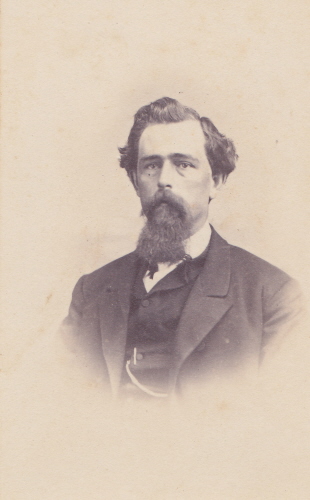
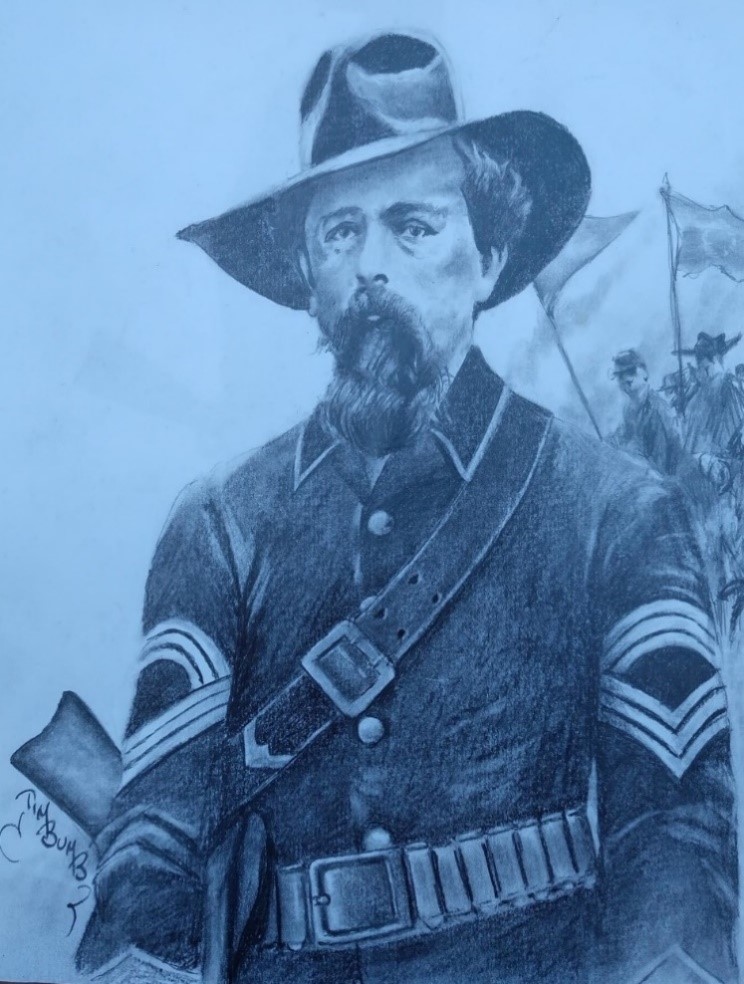
Left - Sergeant Major William H. Sharrow (Courtesy of George Kush) and - Above - (Courtesy of Tim Bumb).